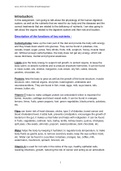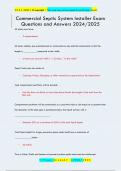name, Unit 8 LA C Nutrition & Health Assignment
Introduction:
In this assignment, I am going to talk about the physiology of the human digestive
system, as well as the nutrients that we need for our body and the diseases and the
correct treatments that are related to the deficiency of nutrients. I am also going to
talk about the organs related to the digestive system and their role and location.
Description of the functions of key nutrients -
Carbohydrates make up the main part of the diet and provide the body with energy
and they break down starch into glucose. They can be found in potatoes, rice,
cereals, bread, sugar, juices, fizzy drinks, fruits, milk, sorghum, honey, muscle meat,
etc. Without enough carbohydrates, the body does not get any energy, which will
cause dizziness, mental and physical weakness.
Lipids give the body energy to support cell growth, to protect organs, to keep the
body warm, to absorb nutrients and to produce important hormones. It can be found
in meat, butter, oils, cheese, margarine, nuts cream, oily fish, cakes, biscuits,
pastries, chocolate, etc.
Proteins help the body to grow as well as the growth of the bone structure, muscle
structure, skin, internal organs, enzymes, haemoglobin, antibodies and
neurotransmitters. They are found in fish, meat, eggs, milk, soya beans, tofu,
cheese, butter, etc.
Vitamin C helps to make collagen protein (an antioxidant) which is important for
bones, muscles, cartilage and blood vessel walls. It can be found in oranges,
lemons, limes, fruits, green peppers, kiwi, green vegetables, blackcurrants, potatoes,
etc.
Fibre can lower risk of heart disease, stroke, type 2 of diabetes, bowel cancer and
blood cholesterol level, it adds bulk, prevents constipation, encourages the growth of
bacteria in the gut, it makes us feel fuller and helps with indigestion. It can be found
in fruits, vegetables, oatmeal, nuts, barley, lentils, kidney beans, quinoa, chickpeas,
split peas, chia seeds, almonds, popcorn, sweet potatoes, dark chocolate, etc.
Water helps the body by keeping it hydrated, to regulate body temperature, to make
body fluids as gastric juice, to remove excretory waste, keep the eye surface moist,
etc. Water can be found in cucumber, tomatoes, oranges, tea, coffee, milk,
watermelon, mushroom, spinach, broccoli, etc.
Vitamin A is used for rod cells in the retina of the eye, healthy epithelial cells,
resisting infections, growth, reducing the risk of cancer and acting as an antioxidant.
1
,name, Unit 8 LA C Nutrition & Health Assignment
It can be found in liver, sweet potatoes, pumpkin, mangoes, egg yolks. green
vegetables, peppers, carrots, spinach, etc.
Vitamin D helps to regulate calcium phosphate deposition in bone, also helps
protect against cancer, heart disease, depression, etc. It can be found in tuna, milk,
salmon, liver, egg yolks, mackerel and herrings, etc.
Vitamin B1 (thiamine) helps to produce fatty acids, synthesizing certain hormones,
breaking down sugar, activates enzymes in respiration and to create certain
neurotransmitters. It can be found in peas, meat, bran, rice husks, acorn squash,
black beans, seeds, etc.
Vitamin B2 (riboflavin) activates enzymes used in respiration, to produce energy, to
break down lipids, etc. and to convert tryptophan into vitamin B3. It can be found in
green vegetables, meat, oatmeal, organ meats, mushrooms, almonds, milk, yoghurt,
etc.
Vitamin B3 (Niacin) activates the enzymes used in respiration and it can be found in
poultry, brown rice, meat, fish, nuts, legumes, grains, etc.
Vitamin B6 activates enzymes used in protein synthesis, breaking down
carbohydrates and fats, brain development and immune function. It can be found in
bananas, green vegetables, organ meats, chickpeas, poultry, potatoes, fortified
cereals, meat, fish, etc.
Vitamin B12 Activates enzymes involved in making nerve, blood, and other cells as
well as for DNA synthesis, fat and protein metabolism and brain and neurologic
function. It can be found in meat and fish
Iron is used to make myoglobin and haemoglobin, to build and repair tissues and to
make hormones, enzymes and other body chemicals. They can be found in soya
bean, meat, fish, prunes, plums, whole wheat bread, etc.
Magnesium helps to maintain electrolyte balance for body fluids, heart function,
bone formation, nerve function, regulate protein synthesis, blood glucose function
and blood pressure regulation.
Iodine is needed in the body to make the thyroxine hormones, which are hormones
that regulate the rate at which chemical reactions take place in our bodies. Iodine
can be found in eggs, seafood, iodised salt, etc.
Part Evidence C.P6 - C.P6 Awarded
2
, name, Unit 8 LA C Nutrition & Health Assignment
Explain the role and location of organs involved in digestion:
Figure 1
Figure 1 - Annets, F. et al (2016)Structure of the digestive system, Pearson BTEC National Applied
Science Student Book 1, Pearson (page 319)
The main digestive organs are shown in Figure 1.
Part Evidence C.P5
Mouth: It is a cavity that is oval-shaped and is placed inside the skull. The lips,
gums, teeth, the palates, vestibule, tongue, salivary glands and mouth cavity are
also part of the mouth. It is the entry point for food after the food enters the mouth,
we grind it with our teeth and break them into much smaller pieces so they can be
easily mixed with the saliva.
Tongue: It is a striated muscle placed on the floor of the mouth. The surface
consists of numerous papillae and taste buds and is attached to the mouth floor by
the frenulum, which is a fold. It helps to mix the food with saliva while chewing and
pushes the food into the throat that goes down the oesophagus.
Salivary glands: They are located in the mouth, there are 3 pairs of them; Parotid
Glands, Submandibular Glands and Sublingual Glands. They get active as people
see or smell the food and they produce saliva, which contains amylase. Amylase is
an enzyme that helps to break down carbohydrates and the saliva also helps to
prevent the mouth and other parts of the digestive system being dry.
3





